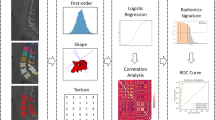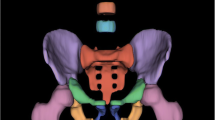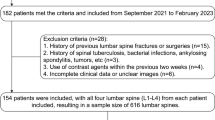Abstract
To assess whether application of a support vector machine learning algorithm to ancillary data obtained from posterior-anterior dual-energy X-ray absorptiometry (DEXA) studies could identify patients with lumbar spine (L1–L4) vertebral body fractures without additional DEXA imaging or radiation. Three hundred seven patients (199 without any fractures of the spine, and 108 patients with at least one fracture of the L1, L2, L3, or L4 vertebral bodies) who had DEXA studies were evaluated. Ancillary data from DEXA output was analyzed. The dataset was split into training (80%) and test (20%) datasets. Support vector machines (SVMs) with 10-fold cross-validation and different kernels were used to identify the best kernel based on the greatest area under the curve (AUC) and the best training vectors in the training dataset. The SVM with the best kernel was then applied to the test dataset to assess the accuracy of the SVM. Receiver operating characteristic (ROC) curves of the SVMs using different kernels in the test dataset were compared using DeLong’s test. The SVM classifier with the linear kernel had the greatest AUC in the training dataset (AUC = 0.9258). The AUC of the SVM classifier with the linear kernel in the test dataset was 0.8963. The SVM classifier with the linear kernel had an overall average accuracy of 91.8% in the test dataset. The sensitivity, specificity, positive predictive value, and negative predictive of the SVM classifier with the linear kernel to detect lumbar spine fractures were 81.8%, 97.4%, 94.7%, and 90.5%, respectively. The SVM classifier with the linear kernel ROC curve had a significantly better AUC than the SVM classifier with the cubic polynomial kernel (P = 0.034) for discriminating between patients with lumbar spine fractures and control patients, but not significantly different from the SVM classifier with a radial basis function (RBF) kernel (P = 0.317) or the SVM classifier with a sigmoid kernel (P = 0.729). All fractures identified by the SVM classifiers were not prospectively identified by the radiologist. SVM analysis of ancillary data obtained from routine DEXA studies can identify lumbar spine fractures without the use of vertebral fracture assessment (VFA) DEXA imaging or radiation, and identify fractures missed by radiologists.


Similar content being viewed by others
References
Cefalu CA: Is bone mineral density predictive of fracture risk reduction? Curr Med Res Opin 20(3):341–349, 2004
Unnanuntana A, Gladnick BP, Donnelly E, Lane JM: The assessment of fracture risk. J Bone Joint Surg Am 92(3):743–753, 2010. https://doi.org/10.2106/JBJS.I.00919
McClung MR: The relationship between bone mineral density and fracture risk. Curr Osteoporos Rep 3(2):57–63, 2005
Schnell S, Friedman SM, Mendelson DA, Bingham KW, Kates SL: The 1-year mortality of patients treated in a hip fracture program for elders. Geriatr Orthop Surg Rehabil 1(1):6–14, 2010. https://doi.org/10.1177/2151458510378105
Panula J, Pihlajamäki H, Mattila VM, Jaatinen P, Vahlberg T, Aarnio P, Kivelä SL: Mortality and cause of death in hip fracture patients aged 65 or older: a population-based study. BMC Musculoskelet Disord 12:105, 2011. https://doi.org/10.1186/1471-2474-12-105
Cameron ID, Chen JS, March LM, Simpson JM, Cumming RG, Seibel MJ, Sambrook PN: Hip fracture causes excess mortality owing to cardiovascular and infectious disease in institutionalized older people: a prospective 5-year study. J Bone Miner Res 25(4):866–872, 2010. https://doi.org/10.1359/jbmr.091029.
Haentjens P, Autier P, Collins J, Velkeniers B, Vanderschueren D, Boonen S: Colles fracture, spine fracture, and subsequent risk of hip fracture in men and women. A meta-analysis. J Bone Joint Surg Am 85-A(10):1936–1943, 2003
Garg MK, Kharb S: Dual energy X-ray absorptiometry: Pitfalls in measurement and interpretation of bone mineral density. Indian J Endocrinol Metab 17(2):203–210, 2013. https://doi.org/10.4103/2230-8210.109659
Preventive Services US, Force T: Screening for osteoporosis: recommendation statement. Am Fam Physician 83(10):1197–1200, 2011
World Health Organization: Assessment of fracture risk and its application to screening for postmenopausal osteoporosis: technical report series 843. Geneva: WHO, 1994
Kanis JA, Gluer CC, for the Committee of Scientific Advisors, International Osteoporosis Foundation An update on the diagnosis and assessment of osteoporosis with densitometry. Osteoporos Int 200011192–202.
O'Malley CD, Johnston SS, Lenhart G, Cherkowski G, Palmer L, Morgan SL: Trends in dual-energy X-ray absorptiometry in the United States, 2000-2009. J Clin Densitom 14(2):100–107, 2011. https://doi.org/10.1016/j.jocd.2011.03.003.
Curtis JR, Laster A, Becker DJ, Carbone L, Gary LC, Kilgore ML, Matthews RS, Morrisey MA, Saag KG, Tanner SB, Delzell E: The geographic availability and associated utilization of dual-energy X-ray absorptiometry (DXA) testing among older persons in the United States. Osteoporos Int 20(9):1553–1561, 2009. https://doi.org/10.1007/s00198-008-0821-xEpub 2008 Dec 24
Bazzocchi A, Ferrari F, Diano D, Albisinni U, Battista G, Rossi C, Guglielmi G: Incidental findings with dual-energy X-ray absorptiometry: Spectrum of possible diagnoses. Calcif Tissue Int 91(2):149–156, 2012. https://doi.org/10.1007/s00223-012-9609-2Epub 2012 May 24
Gregson CL, Hardcastle SA, Cooper C, Tobias JH: Friend or foe: High bone mineral density on routine bone density scanning, a review of causes and management. Rheumatology (Oxford) 52(6):968–985, 2013. https://doi.org/10.1093/rheumatology/ket007Epub 2013 Feb 27
Vasireddy S, Halsey JP: Incidental detection of lumbar Paget’s disease by bone densitometry. Rheumatology (Oxford) 40(12):1424–1425, 2001
Cherian RA, Haddaway MJ, Davie MW, McCall IW, Cassar-Pullicino VN: Effect of Paget’s disease of bone on areal lumbar spine bone mineral density measured by DXA, and density of cortical and trabecular bone measured by quantitative CT. Br J Radiol 73(871):720–726, 2000
Martineau P, Bazarjani S, Zuckier LS: Artifacts and incidental findings encountered on dual-energy X-ray absorptiometry: Atlas and analysis. Semin Nucl Med 45(5):458–469, 2015. https://doi.org/10.1053/j.semnuclmed.2015.02.001
Mehta SD, Sebro R: Random forest classifiers aid in the detection of incidental osteoblastic osseous metastases in DEXA studies. Int J Comput Assist Radiol Surg 14:903–909, 2019. https://doi.org/10.1007/s11548-019-01933-1
Genant HK, Grampp S, Glüer CC, Faulkner KG, Jergas M, Engelke K, Hagiwara S, Van Kuijk C: Universal standardization for dual x-ray absorptiometry: Patient and phantom cross-calibration results. J Bone Miner Res 9:1503–1514, 1994
Lewiecki EM, Binkley N, Morgan SL, Shuhart CR, Camargos BM, Carey JJ, Gordon CM, Jankowski LG, Lee JK, Leslie WD: International Society for Clinical Densitometry best practices for dual-energy X-ray absorptiometry measurement and reporting: International Society for Clinical Densitometry Guidance. J Clin Densitom 19(2):127–140, 2016. https://doi.org/10.1016/j.jocd.2016.03.003Epub 2016 Mar 22
Shen T, Jiang J, Li Y, Wu P, Zuo C, Yan Z: Decision supporting model for one-year conversion Probability from MCI to AD using CNN and SVM. Conf Proc IEEE Eng Med Biol Soc 2018:738–741, 2018. https://doi.org/10.1109/EMBC.2018.8512398
Longato E, Acciaroli G, Facchinetti A, Maran A, Sparacino G: Simple linear support vector machine classifier can distinguish impaired glucose tolerance versus type 2 diabetes using a reduced set of CGM-based glycemic variability indices. J Diabetes Sci Technol 31:1932296819838856, 2019. https://doi.org/10.1177/1932296819838856
Cortes C, Vapnik VN: Support-vector networks. Mach Learn 20(3):273–297, 1995
Wajid SK, Elzaart A, Berbar MA. Eighth international conference computer graphics. 2011. 145–150. DOI:https://doi.org/10.1109/CGIV.2011.31
DeLong ER, DeLong DM, Clarke-Pearson DL: Comparing the areas under two or more correlated receiver operating characteristic curves: A nonparametric approach. Biometrics. 44(3):837–845, 1988
Robin X, Turck N, Hainard A, Tiberti N, Lisacek F, Sanchez J, Müller M: pROC: An open-source package for R and S+ to analyze and compare ROC curves. BMC Bioinformatics 12:77, 2011
Nieves JW, Formica C, Ruffing J, Zion M, Garrett P, Lindsay R, Cosman F: Males have larger skeletal size and bone mass than females despite comparable body size. J Bone Miner Res 20(3):529–535, 2005 Epub 2004 Oct 11
Naganathan V, Sambrook P: Gender differences in volumetric bone density: A study of opposite-sex twins. Osteoporos Int 14(7):564–569, 2003 Epub 2003 Jun 26
Iwaniec UT, Turner RT: Influence of body weight on bone mass, architecture and turnover. J Endocrinol 230(3):R115–R130, 2016. https://doi.org/10.1530/JOE-16-0089Epub 2016 Jun 27
Caffarelli C, Alessi C, Nuti R, Gonnelli S: Divergent effects of obesity on fragility fractures. Clin Interv Aging 24(9):1629–1636, 2014. https://doi.org/10.2147/CIA.S64625.eCollection2014
De Schepper J, Derde MP, Van den Broeck M, Piepsz A, Jonckheer MH. Normative data for lumbar spine bone mineral content in children: Influence of age, height, weight and pubertal stageJ Nucl Med 1991;32(2):216–220.
Tothill P, Fenner JA, Reid DM: Comparisons between three dual-energy X-ray absorptiometers used for measuring spine and femur. Br J Radiol 68(810):621–629, 1995
Hui SL, Gao S, Zhou XH, Johnston, Jr CC, Lu Y, Glüer CC, Grampp S, Genant H: Universal standardization of bone density measurements: A method with optimal properties for calibration among several instruments. J Bone Miner Res 12(9):1463–1470, 1997
Funding
RS was supported by a Radiology Society of North America Research Scholarship.
Author information
Authors and Affiliations
Corresponding author
Ethics declarations
This study was approved by the senior author’s Institutional Review Board and the need for signed informed consent was waived.
Conflict of Interest
The authors declare that they have no conflict of interest.
Additional information
Publisher’s Note
Springer Nature remains neutral with regard to jurisdictional claims in published maps and institutional affiliations.
Rights and permissions
About this article
Cite this article
Mehta, S.D., Sebro, R. Computer-Aided Detection of Incidental Lumbar Spine Fractures from Routine Dual-Energy X-Ray Absorptiometry (DEXA) Studies Using a Support Vector Machine (SVM) Classifier. J Digit Imaging 33, 204–210 (2020). https://doi.org/10.1007/s10278-019-00224-0
Published:
Issue Date:
DOI: https://doi.org/10.1007/s10278-019-00224-0




